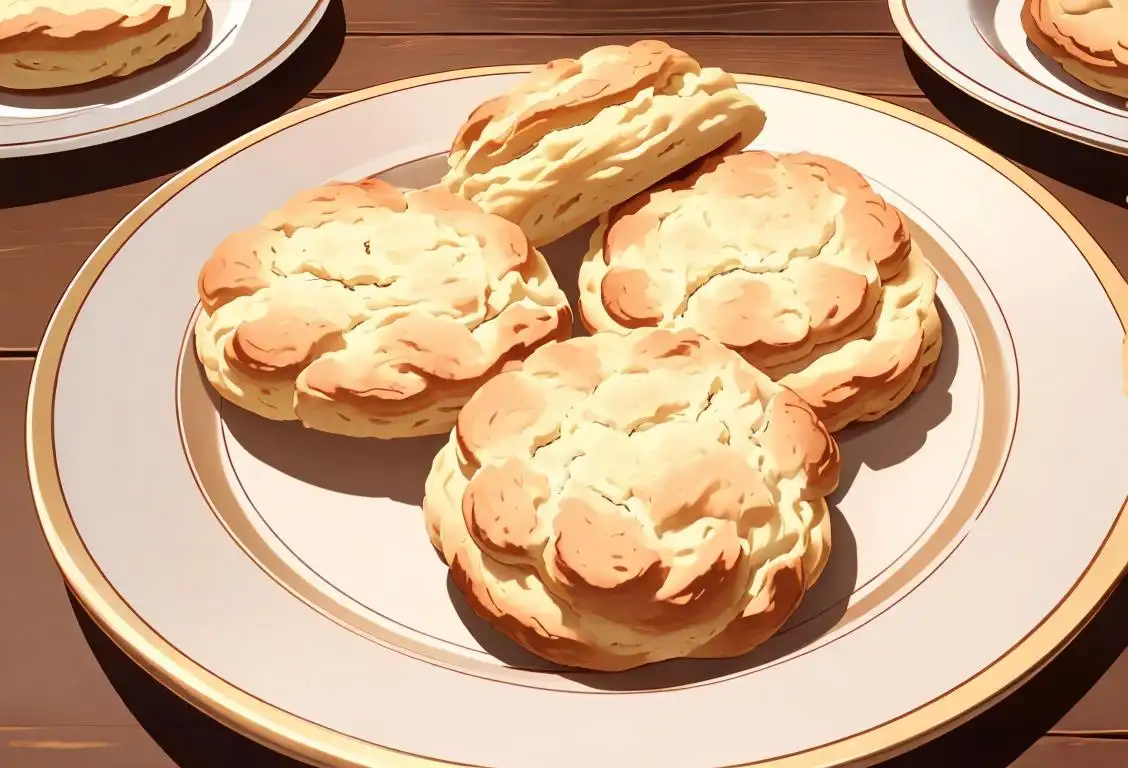National Marshmallow Day

Hey there, marshmallow lovers! Get ready to toast your tastebuds and bounce with joy because National Marshmallow Day is here to add some sweetness to your life. Grab a bag of fluffy goodness, gather your loved ones, and read on to satisfy your craving for all things marshmallow!
When is Marshmallow Day?
It's national marshmallow day on the 19th May.
The Internet Birth of National Marshmallow Day
Every day there seems to be a new reason to celebrate, and on May 19, 2020, the internet decided to give marshmallows their moment in the spotlight. With 13 online mentions, it's safe to say that people were absolutely excited about this delectable treat.
But where did marshmallows come from? Did they just magically appear in a cloud of sugar and happiness? Not quite!
Marshmallows have a long history that dates back to Ancient Egypt. They were originally made from the sap of the marshmallow plant mixed with honey. The resulting concoction was enjoyed by pharaohs and used medicinally in the treatment of coughs and sore throats. Talk about a tasty remedy!
Over the centuries, the recipe for marshmallows evolved, and it wasn't until the 19th century that the familiar marshmallow texture we know and love today was created. The addition of gelatin and egg whites transformed these sweet treats into the fluffy pillows we can't resist.
Celebrating National Marshmallow Day
Now that you know a bit about the history of marshmallows, it's time to dive into the delicious ways to celebrate National Marshmallow Day. Here are a few ideas to kickstart your marshmallow-filled adventure:
- Toasty Marshmallow Delights: Gather around a crackling campfire or fire pit with your loved ones and toast some marshmallows. Whether you prefer them golden brown or charred to perfection, savoring this gooey delight is a timeless tradition.
- Marshmallow Games: Put a twist on classic sports games and organize a marshmallow-themed tournament. From marshmallow relay races to marshmallow target practice, the possibilities are endless. Just be sure to clean up the mess afterwards!
- Marshmallow Fondue: Dip marshmallows into a warm pot of melted chocolate or caramel for a decadent treat. Get creative with different toppings like crushed nuts, sprinkles, or even finely grated orange zest for an extra zing of flavor.
No matter how you choose to celebrate, National Marshmallow Day is all about indulging in the sugary sweetness and creating joyful memories with your loved ones.
Did You Know?
In 1954, the marshmallow-loving creator of the Marshmallow Fluff, Archibald Query, sold the rights of his Fluffernutter sandwich idea to Durkee-Mower Inc. for the sum of $500. Little did he know that his creation would become a lunchtime staple and a beloved childhood treat for generations to come!
History behind the term 'Marshmallow'
2000 BCE
Ancient Beginnings
The history of marshmallows dates back to around 2000 BCE in ancient Egypt. The Egyptians discovered the mallow plant, from which they extracted sap and mixed it with honey to create a sweet treat. This concoction was reserved for gods and the Pharaohs, and it was considered a delicacy of the high-class society.
2000 BC
The Ancient Origins
Marshmallows can trace their roots back to ancient Egypt, where the sap from the mallow plant was combined with honey to create a sweet treat. These marshmallow confections were considered a delicacy and were reserved for royalty and gods.
6000 BCE
Ancient Egyptian Treat
Marshmallows have a fascinating history that dates back to ancient times. The first known marshmallow-like treat was enjoyed by the ancient Egyptians around 6000 BCE. They would extract sap from the mallow plant, mix it with honey, and create a sweet treat with a soft, chewy texture. These confections were highly regarded and often reserved for royalty and gods.
2000 BCE
Ancient Origins
Marshmallows trace their origins back to ancient Egypt, where the sap of the marshmallow plant (Althaea officinalis) was used to create a sweet delicacy. The Egyptians would extract the sap and mix it with honey and grains to produce a treat reserved for gods and pharaohs. These early marshmallows were considered a luxury item and were only enjoyed by the elite.
2000 BCE
Ancient Origins
Marshmallows have their earliest roots in ancient Egypt, where the sap of the mallow plant was combined with honey to create a sweet treat. This concoction was reserved only for gods and royalty, representing a symbol of luxury and indulgence.
2000 BCE
The Ancient Egyptian Delight
Marshmallow's history can be traced back to around 2000 BCE in ancient Egypt. The main ingredient of marshmallow, the mallow plant, was discovered and highly regarded for its healing properties. Egyptians extracted sap from the mallow plant's roots and mixed it with honey, creating a sweet and sticky treat enjoyed by pharaohs and nobility.
2000 BC
Ancient Origins
The history of marshmallows can be traced back to around 2000 BC, where ancient Egyptians made a sweet treat using the sap of the marshmallow plant. The sap was extracted and mixed with honey and grains to create a delicacy reserved for gods and royalty. These early marshmallows were consumed for their medicinal properties and were used to soothe sore throats and relieve coughs.
2000 BC
Ancient Roots
Marshmallow's history can be traced back to ancient Egypt, where the plant from which it is derived, Althaea officinalis, grew along the banks of the Nile. Ancient Egyptians used the sap of the marshmallow plant to make a sweet treat by mixing it with honey and grains. This confection was reserved for pharaohs and gods and was considered a delicacy.
2000 BC
Ancient Origins
Marshmallow has its roots in ancient Egypt where it was made from the sap of the marshmallow plant (Althaea officinalis). Egyptians would use the sap to make candy-like treats by mixing it with honey and grains. These early confections were a delicacy reserved for the pharaohs and gods.
2000 BC
Ancient Origins
Marshmallow has ancient origins and was originally made from the root sap of the marshmallow plant. Ancient Egyptians were known to cultivate and harvest marshmallow plants for medicinal purposes. The sap was boiled, strained, and sweetened to create a sweet treat similar to modern marshmallows.
2000 BC
Early Discovery
Marshmallow roots are discovered in ancient Egypt. The sap from the root is mixed with honey to create a medicinal treat.
1800s
Medical Marvel
In the 19th century, marshmallow root was used medicinally. It was prized for its soothing properties and ability to relieve sore throats and respiratory issues. People would make a thick syrupy substance out of marshmallow root and sugar, which eventually evolved into the modern marshmallow we know today.
200 AD
Expanding Horizons
Marshmallow is introduced in Greece. The Greeks discover the sweetening properties of marshmallow sap and begin using it in desserts and candies.
200 AD
Greek Medicinal Use
In ancient Greece, marshmallow roots were widely used for their medicinal properties. The Greeks believed that consuming marshmallow could soothe and heal various ailments, ranging from sore throats to digestive issues. The plant's mucilaginous nature was particularly valued for its ability to alleviate symptoms and aid in the healing process.
19th Century
Industrial Revolution Brings Innovations
In the 19th century, the process of making marshmallows underwent significant changes. The French started extracting the sap from marshmallow roots and whipping it with egg whites and sugar. However, the process was labor-intensive and time-consuming.
1800s
Medicinal Uses
In the 19th century, marshmallows started to be used for their medicinal properties. The mucilage found in marshmallow root was believed to have soothing effects on sore throats and coughs. Pharmacists and doctors began prescribing marshmallow-based remedies to their patients, who would consume the treat as a form of medicine. However, this early version of marshmallows had a bitter taste due to the absence of sugar.
19th Century
Marshmallow as Medicine
In the 19th century, marshmallow was used as a remedy for sore throats and coughs. Marshmallow root contains mucilage, a thick and sticky substance that can soothe irritation in the throat. People would consume marshmallow candies or drink marshmallow root tea for its medicinal benefits.
19th Century
Evolution of Ingredients
In the 19th century, the recipe for marshmallows began to evolve. Marshmallow makers started replacing the marshmallow plant sap with gelatin, which was easier to obtain and use. Gelatin provided a desirable texture, making marshmallows soft and chewy. This change in ingredients allowed for mass production and made marshmallows more accessible to the general public.
200-300 CE
The Rise of Marshmallow Confections
During the time of the Roman Empire in the 2nd and 3rd centuries CE, marshmallow took on a new form. The sap from the mallow plant was replaced with egg whites and sugar. This mixture was whipped to create a soft and foamy texture, forming the basis of what we now know as marshmallow confections.
19th Century
Medicinal Marshmallows
In the 19th century, marshmallows began to be used medicinally. The mallow plant extract was combined with egg whites, sugar, and gelatin to create a soothing and demulcent cough remedy known as marshmallow lozenges. These early marshmallows were shaped into tiny cylinders and consumed for their medicinal properties.
2000 BCE
Greek Medicinal Use
In ancient Greece, around 2000 BCE, marshmallows were valued not only as a delicious treat but also for their medicinal properties. The Greeks used marshmallow root, also from the mallow plant, to soothe sore throats, treat coughs, and heal wounds. This herbal remedy became popular and spread throughout ancient Greek society.
19th Century
Medieval Medicinal Use
During the medieval period, marshmallow root was used for its medicinal properties. It was believed to treat various ailments such as sore throats, digestive issues, and respiratory problems. The roots were boiled in water to create a thick, gelatinous substance that was consumed as a remedy.
1850
Marshmallow Modernization
The process of marshmallow production took a significant leap forward in 1850 when French candy makers Alexandre Doumak and Antoine Rumpelmayer invented an industrial technique to make marshmallows more affordable and accessible. They replaced the mallow plant extract with gelatin, which offered a more consistent and efficient base for marshmallow production.
1850
Marshmallow Candy Inventor
In 1850, a French confectioner named Alexandre Bécquerel revolutionized the marshmallow industry by developing a process to mass-produce marshmallow candies. He replaced the mallow plant sap with gelatin, which resulted in a lighter and fluffier texture. This innovation made marshmallows more accessible to the general public.
Late 19th Century
Marshmallow Candy
During the late 19th century, marshmallows were primarily consumed as a homemade candy. The process of whipping the marshmallow mixture and then letting it cool and harden created a fluffy, airy texture. Individuals would often shape the mixture into small discs or balls, dust them with powdered sugar, and enjoy them as a sweet treat.
19th Century
Marshmallow Candies
The modern concept of marshmallows as candies began to take shape in the 19th century. Around this time, confectioners started replacing the marshmallow plant sap with gelatin, which provided a more stable and consistent texture. The use of gelatin allowed for mass production and gave marshmallows their characteristic fluffy, chewy, and melt-in-your-mouth consistency.
19th Century
Marshmallow Modernization
French confectioners begin adding egg whites and sugar to the marshmallow sap, creating a lighter, fluffier, and tastier version of marshmallow.
1948
Marshmallow Fluff Takes Center Stage
It was in 1948 when the iconic Marshmallow Fluff was introduced by two Massachusetts men. They revolutionized the marshmallow industry by creating a spreadable form of marshmallow that became popular for uses in sandwiches, desserts, and baking.
Late 19th Century
The Modern Marshmallow
The modern marshmallow as we know it today was born in the late 19th century. In 1850, French confectioner, Alexandre Bousquet, discovered a way to mass-produce marshmallows using gelatin instead of the plant extract. This new method made marshmallow production more efficient and allowed for consistent texture and taste. The addition of sugar and flavorings further enhanced its appeal.
19th Century
Modern Marshmallow Invention
The modern marshmallow as we know it today was invented in the 19th century. French confectioners discovered how to extract the sap from the marshmallow plant and mix it with sugar, water, and egg whites to create a fluffy, light-textured confection. This new version of marshmallow became popular as a candy treat.
1800s
Marshmallow's Pioneering Industrialization
In the 19th century, marshmallow production evolved significantly thanks to technological advancements. The process of creating marshmallow shifted from being a labor-intensive task to a more industrialized one. The use of gelatin, corn syrup, and starch allowed for the mass production of marshmallows, making them more accessible to the general public.
19th Century
Modern Marshmallow Innovation
The modern marshmallow as we know it today emerged in the 19th century. In the early 1800s, French confectioners began replacing the mallow root extract with gelatin, which provided a consistent texture and improved shelf life. This innovation made marshmallows more accessible and allowed for mass production.
Late 19th Century
Modern Marshmallow Recipe
Around the late 19th century, French confectioners started using gelatin instead of marshmallow root sap to create a more stable and consistent marshmallow. The gelatin-based marshmallows became popular due to their fluffy texture, sweet taste, and ability to stay firm for longer periods.
Early 20th Century
Marshmallow Roasting
The tradition of roasting marshmallows over an open fire gained popularity in the early 20th century. This can be attributed to the introduction of the metal skewer, which made it easier to hold marshmallows over a flame. The toasty exterior and gooey interior of a roasted marshmallow became a beloved campfire treat and an integral part of activities like s'mores making.
Early 20th Century
Campfire Treats
Marshmallows gained popularity as a campfire treat in the early 20th century. People discovered that by toasting marshmallows over an open flame, they could achieve a deliciously golden crust with a gooey center. This simple pleasure became a staple of summer gatherings, making marshmallows synonymous with camping and outdoor activities.
1950s
Marshmallow Roasting Tradition
Roasting marshmallows over an open fire became a popular tradition in the United States during the 1950s. The crispy outer layer and gooey center of a toasted marshmallow became a favorite treat at campfires and backyard gatherings. The tradition of roasting marshmallows continues to be enjoyed today.
1948
Marshmallow Mass Production
Alex Doumak invents and patents the extrusion process for making marshmallows. This allows for mass production and consistent shape and texture.
1948
Marshmallow Peeps
A significant milestone for marshmallows occurred in 1948 when Just Born, a candy company based in the United States, introduced the iconic Marshmallow Peeps. These small, brightly colored marshmallow candies, in the shape of chicks, became an instant hit and remain a beloved Easter treat to this day. Just Born produces over 5.5 million Marshmallow Peeps every day!
Early 20th Century
Mass Production and Commercialization
In the early 20th century, marshmallows transitioned from homemade treats to mass-produced confections. The introduction of industrial manufacturing techniques and advancements in food technology made it possible to produce marshmallows in large quantities. Marshmallows became widely available and affordable, leading to their increased popularity.
Early 20th Century
Marshmallow Roasting
The introduction of marshmallow roasting took place in the early 20th century. The soft, sweet confection became a popular addition to campfire gatherings. People would place marshmallows on a stick and roast them over an open flame until they turned golden brown and gooey on the inside. The joy of roasting marshmallows led to the creation of timeless treats like s'mores.
1948
Marshmallow Peeps
In 1948, Just Born, a candy company based in the United States, introduced a new marshmallow product known as Marshmallow Peeps. Originally designed to be consumed during Easter, these brightly colored chick-shaped marshmallows gained immense popularity. Over time, Peeps expanded to include various shapes and flavors, becoming an iconic marshmallow brand.
1950
Modern Marshmallows Shape Up
In the 1950s, the recipe for marshmallows changed once again. Instead of using the mallow plant, a gelatin substitute was developed, which allowed for easier mass production. This change paved the way for the fluffy, uniform marshmallows we know today.
1948
The Introduction of Marshmallow Peeps
In 1948, Just Born, Inc., a candy company based in the United States, introduced a new marshmallow confection called 'Marshmallow Peeps.' These cute and colorful marshmallow chicks quickly became an iconic Easter treat. Over the years, Marshmallow Peeps expanded their range, including different shapes and holiday-themed varieties, gaining a devoted following.
1948
Marshmallow Innovation
In 1948, American candy company Just Born introduced the popular Marshmallow Peeps. These brightly colored marshmallow chicks were a hit during Easter season, becoming an iconic symbol of the holiday. Marshmallow Peeps came to represent a delicious blend of artistry and confectionery.
1992
Marshmallow Fluff
In 1992, the iconic Marshmallow Fluff was awarded a patent by the United States Patent and Trademark Office. Marshmallow Fluff, a sweet spreadable marshmallow cream, became a popular ingredient in recipes and sandwiches. It remains a beloved classic, especially in the New England region of the United States, where it originated.
Late 20th Century
Campfire Staple
Marshmallows have become synonymous with campfires and summer gatherings. Roasting marshmallows over an open flame to create the perfect gooey s'more has become a beloved tradition for many. The unique combination of the slightly caramelized exterior and the soft, melty interior has made marshmallows an essential ingredient for outdoor cooking and a symbol of cozy nostalgia.
1948
Marshmallow Fluff
In 1948, the iconic marshmallow spread called Marshmallow Fluff was introduced in the United States. Marshmallow Fluff, a smooth and creamy marshmallow treat, gained fame for its use in sandwich recipes such as the classic Fluffernutter. Marshmallow Fluff became a beloved American ingredient and a staple in many households.
1950s
Marshmallow Fluff
In the 1950s, marshmallow fluff was introduced and quickly gained popularity. Marshmallow fluff, also known as marshmallow creme, became a staple ingredient in various recipes such as fluffernutters, ice cream toppings, and as a filling for cakes and pies. Its smooth, spreadable consistency made it a versatile ingredient in both sweet and savory dishes.
1992
Marshmallows in Pop Culture
Marshmallows have become intertwined with popular culture in various forms. In 1992, the television series 'Veronica Mars' made its debut, starring Kristen Bell as the titular character. The show's fans, affectionately called 'Marshmallows,' embraced the name, and it became synonymous with Veronica Mars enthusiasts. This highlights the cultural impact and versatility of the term 'marshmallow' beyond its tasty confectionery origins.
Late 20th Century
Marshmallow Roasting
Roasting marshmallows over an open fire became prevalent in the late 20th century, with the rise of camping and outdoor activities. The gooey texture and sweet taste of a toasted marshmallow sandwiched between graham crackers and chocolate gave birth to the beloved classic campfire treat, s'mores.
1954
Marshmallow Peeps Debut
Just Born introduces the iconic Marshmallow Peeps in the United States. These colorful, chick-shaped marshmallow sweets become an Easter tradition and a cultural phenomenon.
20th Century
Marshmallow Fluff
In the early 20th century, a new form of marshmallow called 'Marshmallow Fluff' was introduced. Marshmallow Fluff is a spreadable marshmallow product that gained popularity in the Northeastern regions of the United States. It became a key ingredient in various recipes, including the famous 'Fluffernutter' sandwich made with peanut butter and Marshmallow Fluff.
1992
Marshmallow Peeps Take Off
In 1992, Marshmallow Peeps made their debut. These adorable marshmallow chicks, covered in colored sugar, gained immense popularity during the Easter season. Today, Peeps have become an iconic symbol of Easter and are enjoyed by sweet enthusiasts worldwide.
1948
Marshmallow Peeps
In 1948, the Just Born candy company introduced Marshmallow Peeps, a popular marshmallow candy shaped like chicks. Originally produced by hand-squeezing marshmallow through a pastry tube, the process was later automated, leading to the mass production and widespread availability of Peeps. They have since become an iconic symbol of Easter and are enjoyed by people of all ages.
Present Day
Modern Marshmallow Variations
In recent years, marshmallows have undergone a delightful transformation. Artisan marshmallow makers have infused creativity into their creations, experimenting with unique flavors like lavender, matcha, and salted caramel. Marshmallows have also found their way into various desserts, such as cakes, cookies, and hot beverages, serving as a versatile and indulgent ingredient in the culinary world.
Modern Era
Marshmallow Innovations
In the modern era, marshmallows have continued to evolve, inspiring various innovative creations. Marshmallow cereal, hot cocoa marshmallows, flavored marshmallows, and gourmet marshmallows have become popular. Additionally, marshmallow-themed events and festivals celebrate the versatility and whimsical nature of this sugary delight, delighting people of all ages with marshmallow-filled experiences.
21st Century
Marshmallow Art and Innovation
In the 21st century, marshmallows have evolved beyond just a sweet treat. Artists and innovators have used marshmallows as a medium for creating edible sculptures, intricate designs, and even intricate s'mores recipes. Marshmallows continue to inspire creativity and experimentation in the culinary world.
Present Day
Marshmallow Madness
Today, marshmallows have become a versatile ingredient used in a myriad of delicious recipes, ranging from hot cocoa toppings to decadent desserts. They continue to captivate people of all ages with their fluffy texture and delightful sweetness. Whether enjoyed on their own or as an ingredient, marshmallows remain a beloved treat throughout the world.
1992
Marshmallow Fluff Festival
The first Marshmallow Fluff Festival is held in the city of Somerville, Massachusetts. This annual event celebrates the love for marshmallow fluff with various activities and contests.
Present
Marshmallow Varieties
Marshmallows have evolved into countless variations, including flavored, chocolate-coated, and stuffed marshmallows. They are enjoyed in s'mores, hot chocolate, and various desserts worldwide.
Did you know?
In 1954, the creator of Marshmallow Fluff sold the rights of his Fluffernutter sandwich idea for $500.Tagged
food fun loved onesFirst identified
18th September 2015Most mentioned on
19th May 2020Total mentions
13Other days
Biscuit Day
Cheese Lovers Day
Cheese Pizza Day
Agriculture Day
Bacon Day
Medal Of Honor Day
Pumpkin Day
Foundation Day
Guac Day
Drink A Beer Day









